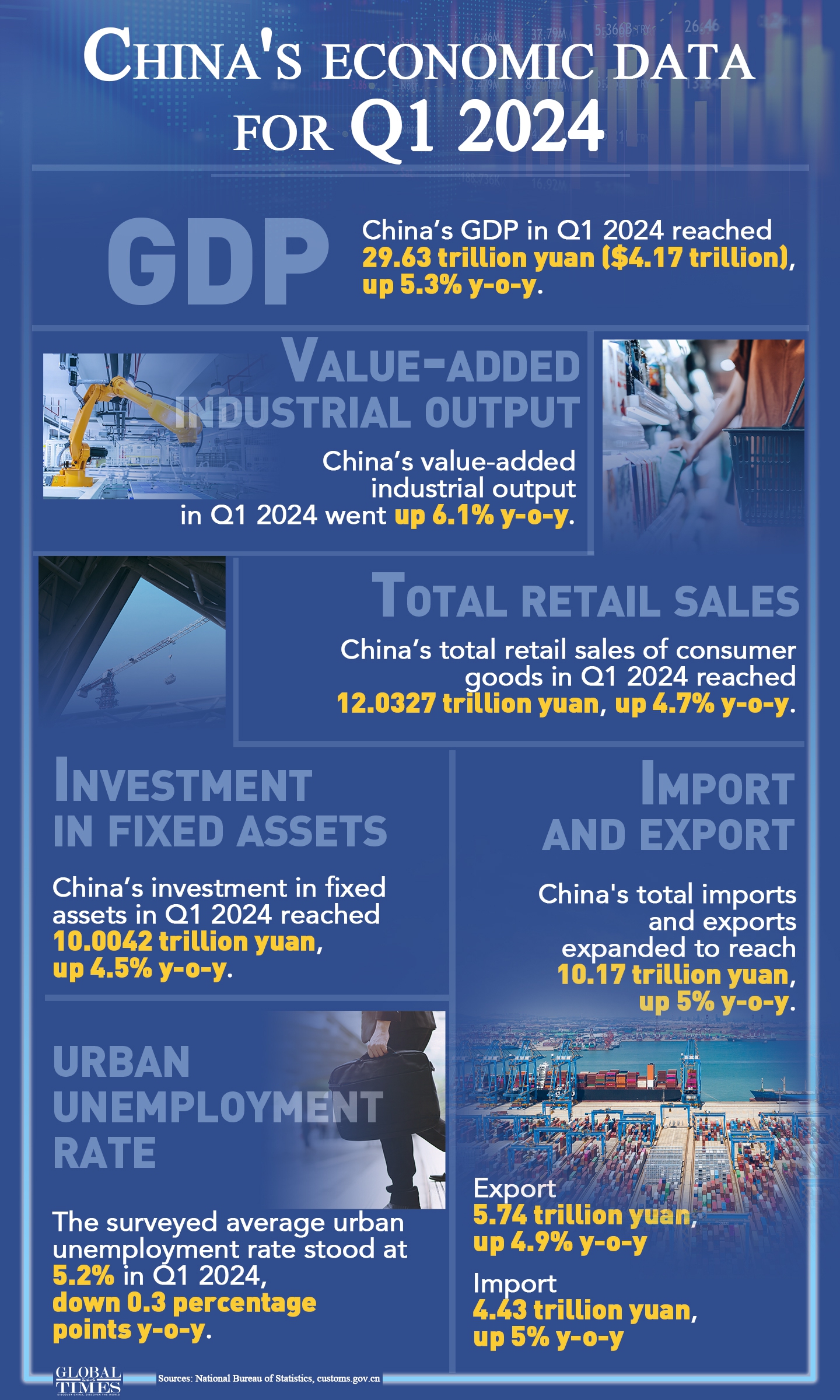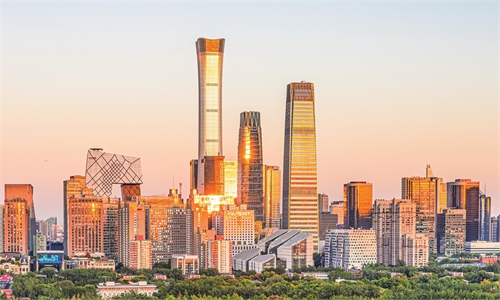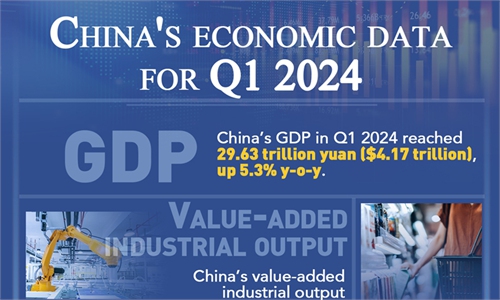
China's economic data for Q1 2024 Graphic: Xu Zihe/GT
China's GDP reached 29.63 trillion yuan ($4.09 trillion) in the first quarter, up 5.3 percent year-on-year. The national economy continued its good momentum, building on a strong start to the year.
In the first three months of the year, major economic indexes - whether supply or demand, external or internal - continued to show improvement. Meanwhile, the economic structure continues to see optimization and the development of new quality productive forces is picking up speed, boosting confidence that the Chinese economy can navigate through treacherous shoals.
Looking ahead, the Chinese economy's overall trend of steady, long-term growth will not change, and the country will cultivate advantages supporting its long-term growth on the basis of achieving economic prosperity in the short term, analysts said.
A good start to the year
In the first three months of the year, the country's GDP grew by 5.3 percent year-on-year, up 1.6 percent from the fourth quarter of 2023 and higher than the annual GDP growth target for 2024. The manufacturing purchasing managers' index (PMI) bounced back to expansion territory in March, while services PMI reached its highest point since July 2023, underscoring growing market expectations and confidence in the economy.
International financial institutions Goldman Sachs and Citi Group have both raised their forecasts for China's economic growth in 2024, positive about China's achievement of its economic growth target in 2024. The vote of confidence showcases their positive expectations for China's economic growth in 2024 and their confidence in China's economic resilience. Amid unpredictable changes across the globe, China remains the engine of world economic growth.
Between January and March, the country's investment in fixed assets grew by 4.5 percent year-on-year, 1.5 percentage points faster than that of the previous year. Specifically, investment in construction and installation grew by 4.6 percent year-on-year and in the purchase of equipment and instruments it jumped by 17.6 percent year-on-year, indicating that companies have been actively replenishing inventory, expanding production and exploring more potential.
The role of consumption in driving economic growth is increasingly remarkable. In the first quarter, the retail sales of consumer goods grew by 4.7 percent year-on-year and online retail sales surged by 12.4 percent, showcasing a vibrant consumption market driven by online spending and digital marketing. It's worth noting that the country's consumption structure continues to improve, with residents showing enthusiasm for travel during holidays; the number of inbound and outbound visitors is gradually recovering to normal and box-office revenue has repeatedly been hitting record-high levels.
In addition, the country's industrial sector continued to see improvement in the first quarter. The total value added of industrial enterprises above the designated size rose by 6.1 percent year-on-year in the first two months, while their total profits went up by 10.2 percent. Along with a new round of large-scale equipment renewals as well as domestic and external demand recovery, China's industrial manufacturing is expected to see a rapid growth cycle. As a result, the country's employment sector will also see improvement.
The country's foreign trade sector has also seen improvement despite external disruptions, with increased expectations and optimization in import and export structure. In the first two months, China's actual use of foreign investment exceeded 100 billion yuan, showing that China remains a promising destination for foreign investment and a top choice for establishing businesses. The continuous inflow of foreign capital injects vitality into the Chinese economy.
Accelerated economic transition
China's post-COVID-19 economic recovery is characterized by undulating progress, with twists and turns sometimes, and the prospects are decided by economic structure adjustments and upgrading as well as transition from old to new growth drivers. The boost from new industrialization benefits the application of digital, intelligent and other new technologies, providing momentum for the upgrading of old growth drivers and the cultivation of new ones. Consolidating the smooth circulation of the domestic economic system by further removing barriers will create new opportunities for consumption upgrades.
Meanwhile, there are many highlights in the country's new industrialization transition, with the digital economy growing. In the first quarter, investment in high-tech industries grew by 11.4 percent year-on-year, in which the investment in aerospace manufacturing and in manufacturing of computers and office devices grew by 42.7 percent and 11.8 percent, respectively. This shows that the development of emerging industries and new infrastructure like 5G and artificial intelligence (AI) is gaining pace.
As representatives of new quality productive forces, new technologies like 5G and AI contribute to the transformation of traditional industries, while nurturing new industries. In line with the guidelines of the central government, provinces' cultivation of specialty industries based on their own situation not only achieved growth driven by traditional and strategic emerging industries but also boosted the transition from old to new growth drivers.
New types of consumption are becoming mainstream. Along with the steady growth of residents' income, Chinese consumers have shifted from paying attention to quantity to quality and from consumption based on imitation to personalized, customized and diversified consumption. In the first quarter, the real growth rate of the nationwide per capita disposable income was 6.2 percent year-on-year, higher than the GDP growth rate. The rise in income has driven consumption growth and structural improvement.
The growth of the private sector continues to be facilitated. In the first two months of the year, private investment accounted for 52.6 percent of national total investment, up 2.2 percentage points from 2023. Private sector investment grew by 0.4 percent year-on-year, reversing the trend of decline seen over the previous five months. Along with the rollout of more policies to support the private economy, their role as a new force in boosting Chinese modernization will be more substantial and the fundamentals for the high-quality development of the private economy will be more stable.
Confidence in bright prospects
The continuous recovery of China's economy is not accidental but a result of resilience and development potential. The reason why the economy can forge ahead steadily despite challenges around the globe lies in both its short-term policies and long-term sound momentum.
In the short-term, China has ample policy room, with a package of policies already in place continuing to produce effects. These policies, aimed at addressing practical issues and difficulties in economic development, play a crucial role in ensuring the continuous rebound of the economy. China has gained advantages in human resources, new technologies and material resources that have accumulated since the reform and opening-up.
Despite a good start in the first quarter, it should be noted that China still faces some difficulties and challenges, including a lack of effective demand, weak social expectations, hidden risks, and an external environment that is increasingly complex and uncertain.
However, those challenges cannot hinder the Chinese economy. China is able to handle difficulties and challenges and to promote high-quality development by acting on the principle of seeking progress while maintaining stability, promoting stability through progress, establishing the new before abolishing the old, and deepening reforms.
Yuan Lei is a research fellow at the Institute of Economics under the Chinese Academy of Social Sciences; Zhang Peng is an associate research fellow at the Institute of Economics under the Chinese Academy of Social Sciences. bizopinion@globaltimes.com.cn



